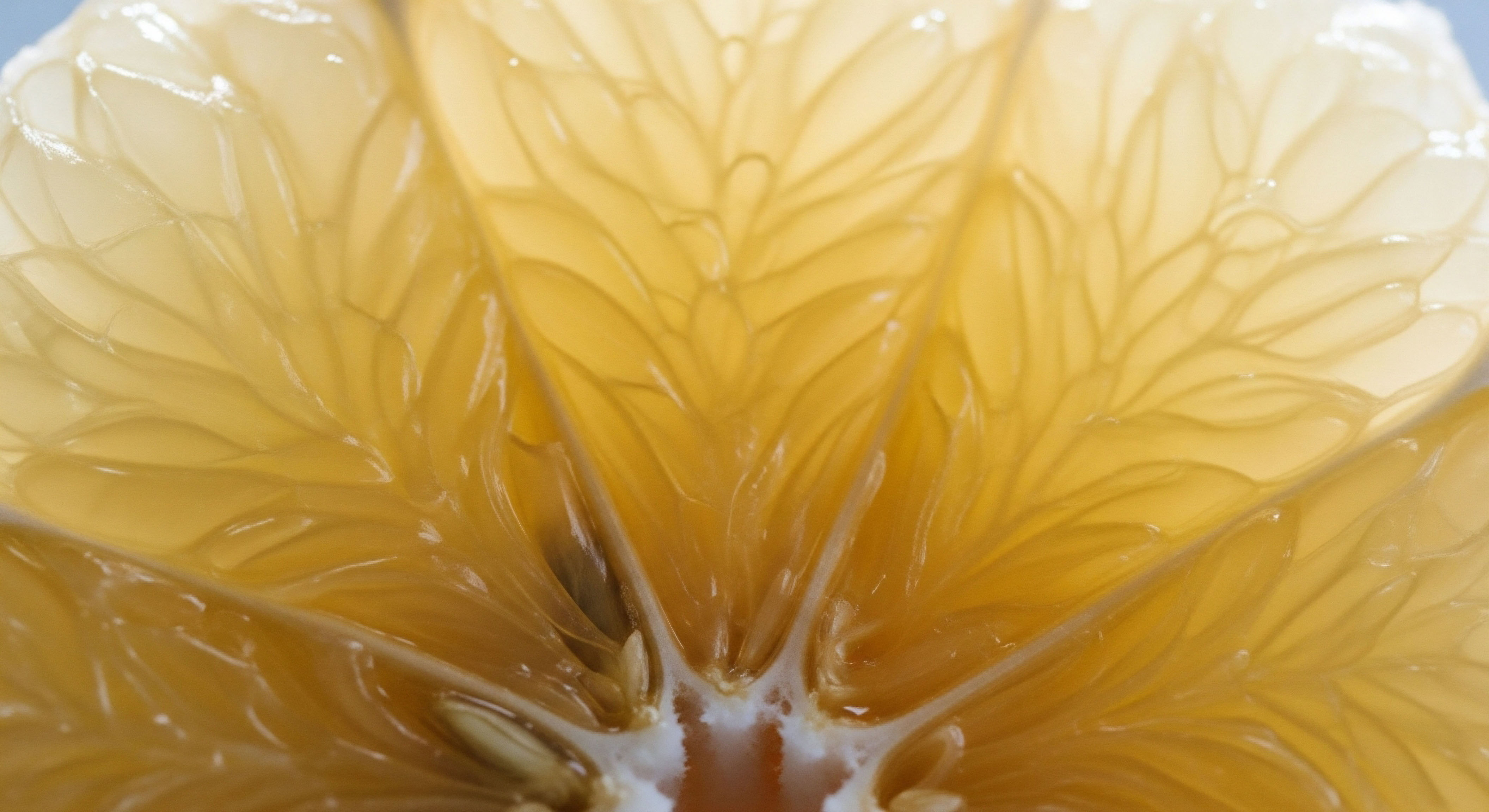

Fundamentals
You have arrived at a point of profound biological transition. The decision to conclude a testosterone replacement protocol is a deliberate step toward reclaiming your body’s innate capacity to produce its own hormonal architecture. This process is an intricate recalibration of a silent, powerful internal communication network.
Your lived experience during this time ∞ the fluctuations in energy, mood, and physical capacity ∞ is a direct reflection of this underlying biological dialogue reawakening. The question of whether lifestyle factors can influence this delicate process is central to your success. The answer is an emphatic yes. The choices you make in your daily life, specifically regarding nutrition and physical activity, provide the foundational support that determines the efficiency and robustness of your endocrine system’s restoration.
Think of your hormonal system, the Hypothalamic-Pituitary-Gonadal (HPG) axis, as a finely tuned orchestra. The hypothalamus, a small region in your brain, is the conductor. It sends out a rhythmic pulse, a molecule called Gonadotropin-Releasing Hormone (GnRH). This is the conductor’s beat.
The pituitary gland, another structure at the base of the brain, is the lead violinist, watching the conductor intently. In response to the GnRH pulse, it plays its own notes ∞ Luteinizing Hormone (LH) and Follicle-Stimulating Hormone (FSH). These hormonal signals travel through the bloodstream, carrying the conductor’s instructions to the orchestra’s percussion section ∞ the testes.
When LH reaches the Leydig cells within the testes, it signals them to produce testosterone. During a testosterone optimization protocol, the body receives testosterone from an external source. Hearing this loud, externally-produced music, the conductor (the hypothalamus) lowers its baton, and the lead violinist (the pituitary) goes quiet. The system becomes dormant because the final sound is already present.
A post-TRT protocol, using compounds like Gonadorelin or Clomiphene, acts as a prompter, specifically designed to get the conductor and lead violinist to start the music again. These medications stimulate the hypothalamus and pituitary, urging them to resume their signaling roles.
Yet, for this to work effectively, the instruments themselves must be in pristine condition, the musicians must be fed and rested, and the concert hall’s acoustics must be optimal. This is where diet and exercise become direct biological inputs. They are the very building blocks for the instruments and the energy source for the musicians.
A body burdened by inflammation, nutrient deficiencies, or metabolic dysfunction is like an orchestra trying to perform with broken strings and exhausted players in a hall with poor sound quality. The signals may be sent, but the resulting music will be faint and discordant.
Lifestyle choices provide the essential biological resources that enable the body’s hormonal system to effectively respond to a post-TRT restart protocol.

The Role of Nutrition in Hormonal Precursors
Your endocrine system does not create hormones from nothing. It requires specific raw materials, which are supplied directly through your diet. Testosterone itself is synthesized from cholesterol. Therefore, a diet severely lacking in healthy fats can deprive your body of the fundamental substrate needed for hormone production.
This is why healthy sources of fat from avocados, olive oil, and nuts are integral to a recovery plan. They provide the necessary cholesterol backbone for steroidogenesis, the biochemical pathway that converts cholesterol into testosterone.
Furthermore, specific micronutrients function as essential cofactors in this manufacturing process. They are the skilled technicians required at specific points on the assembly line.
- Zinc ∞ This mineral is directly involved in the function of enzymes that facilitate testosterone production. A deficiency in zinc can impair the testes’ ability to respond to the LH signal sent from the pituitary. Oysters, red meat, and shellfish are potent sources.
- Vitamin D ∞ Often called the “sunshine vitamin,” it functions more like a hormone within the body. Receptors for vitamin D are present in the hypothalamus, pituitary, and testes, indicating its direct role in regulating the HPG axis. Fatty fish and fortified foods can supply this vital nutrient.
- Magnesium ∞ This mineral plays a part in modulating the activity of Sex Hormone-Binding Globulin (SHBG), a protein that binds to testosterone in the bloodstream. By managing SHBG levels, magnesium helps ensure that more of the testosterone produced is in its “free” or bioavailable state, able to exert its effects on tissues.
Conversely, a diet high in processed foods, refined sugars, and excessive alcohol can actively sabotage this recovery. Sugary foods cause sharp spikes in insulin, a hormone that can suppress the HPG axis. Chronic inflammation, driven by processed ingredients and unhealthy fats, creates a hostile systemic environment that interferes with the delicate signaling between the brain and the gonads. It is the biological equivalent of static on the communication lines, making it difficult for the signals to be heard clearly.

How Exercise Primes the Endocrine Engine
Physical activity, particularly resistance training, is a potent stimulator of the HPG axis. The act of lifting weights creates a physiological demand that signals to the body a need for anabolic processes ∞ for building and repair. This demand can encourage the hypothalamus and pituitary to enhance their signaling, effectively turning up the volume on the GnRH, LH, and FSH broadcasts. Studies have demonstrated that both resistance training and high-intensity interval training (HIIT) can lead to increases in testosterone production.
Exercise also improves insulin sensitivity. When your muscles are more sensitive to insulin, your body needs to produce less of it to manage blood sugar. This is beneficial because chronically high levels of insulin are known to interfere with the healthy functioning of the HPG axis. By improving how your body handles glucose, you are creating a more favorable metabolic environment for hormonal recovery.
Finally, exercise is a powerful tool for managing body composition. Excess body fat, particularly visceral fat around the organs, functions as an active endocrine organ itself. It contains high concentrations of the enzyme aromatase, which converts testosterone into estrogen.
During a post-TRT recovery phase, when you are trying to maximize your endogenous testosterone production, preventing this conversion is of high importance. Reducing excess body fat through a combination of diet and exercise helps to lower aromatase activity, ensuring that the testosterone your body works so hard to produce remains as testosterone.


Intermediate
Moving beyond foundational concepts, a successful post-TRT protocol involves a sophisticated understanding of the biochemical feedback loops and metabolic machinery that govern your endocrine system. Success is not merely the presence of a signal from a medication like Clomiphene; it is the body’s ability to receive and act on that signal efficiently.
Lifestyle factors are the primary modulators of this receptivity. They dictate the metabolic environment in which your HPG axis attempts its reactivation, influencing everything from cellular energy status to the genetic expression of key hormonal enzymes.
The protocol itself, often involving a Selective Estrogen Receptor Modulator (SERM) like Clomiphene or Tamoxifen, works by an elegant deception. These compounds bind to estrogen receptors in the hypothalamus. The hypothalamus, seeing these receptors occupied, perceives low estrogen levels. Since estrogen is a downstream product of testosterone, the hypothalamus interprets this as a system-wide deficit in sex hormones.
In response, it increases its GnRH pulse frequency and amplitude, which in turn stimulates the pituitary to release more LH and FSH. Gonadorelin, a synthetic version of GnRH, performs a more direct action, stimulating the pituitary itself. These are the catalysts. Your diet and exercise habits determine the quality and magnitude of the subsequent reaction.

Metabolic Architecture and Hormonal Signaling
Your body’s metabolic state is inextricably linked to its endocrine function. Two conditions, insulin resistance and chronic systemic inflammation, are significant antagonists to HPG axis recovery. They create a physiological environment that actively suppresses gonadal function.

Insulin Resistance and Luteinizing Hormone Pulsatility
Insulin resistance, a condition where cells become less responsive to insulin’s signal to absorb glucose, leads to chronically elevated insulin levels (hyperinsulinemia). This state directly impacts the HPG axis at multiple levels. In the brain, elevated insulin can disrupt the precise, rhythmic pulsation of GnRH from the hypothalamus.
This erratic signaling pattern translates into suboptimal LH release from the pituitary. The Leydig cells in the testes rely on a clear, strong, and pulsatile LH signal to stimulate steroidogenesis. A weak or irregular signal results in diminished testosterone output, even in the presence of a SERM designed to amplify that signal.
A diet structured to reverse insulin resistance is therefore a primary tool for post-TRT success. This involves:
- Prioritizing Complex Carbohydrates ∞ Sources like sweet potatoes, quinoa, and legumes that are high in fiber slow down glucose absorption, preventing the sharp insulin spikes associated with refined carbohydrates.
- Adequate Protein Intake ∞ Protein has a minimal impact on insulin levels and promotes satiety, helping to prevent overeating and subsequent fat gain that worsens insulin resistance.
- Strategic Fat Consumption ∞ Monounsaturated and omega-3 fatty acids, found in olive oil, avocados, and fatty fish, have been shown to improve insulin sensitivity.

Chronic Inflammation the Suppressive Cytokine Milieu
Visceral adipose tissue (fat surrounding the organs) is a metabolically active factory for pro-inflammatory cytokines like Tumor Necrosis Factor-alpha (TNF-α) and Interleukin-6 (IL-6). These molecules are not localized irritants; they are systemic signals that can suppress the HPG axis.
They have been shown to directly inhibit GnRH release from the hypothalamus and blunt the ability of the Leydig cells to produce testosterone in response to LH. A lifestyle that promotes a low-inflammatory state is therefore a non-negotiable component of an effective recovery.
An anti-inflammatory dietary approach includes a high intake of colorful fruits and vegetables rich in polyphenols and antioxidants, consumption of omega-3 fatty acids, and the use of spices like turmeric and ginger. It also requires the strict avoidance of inflammatory triggers like industrial seed oils, trans fats, and processed foods high in sugar.
The metabolic environment, specifically insulin sensitivity and inflammatory status, directly regulates the receptivity of the HPG axis to restart signals.

Advanced Exercise Programming for Endocrine Recalibration
While all exercise is beneficial, specific modalities offer unique advantages during a post-TRT recovery phase. The goal is to create a potent anabolic signal, improve metabolic health, and manage cortisol, the body’s primary stress hormone, which can be suppressive to the HPG axis when chronically elevated.

How Does Resistance Training Stimulate Testosterone Synthesis?
Resistance training, particularly using large, compound movements like squats, deadlifts, and presses, is the most effective form of exercise for stimulating the HPG axis. The mechanical tension and metabolic stress generated by these movements trigger a cascade of responses.
This includes the acute elevation of hormones like testosterone and growth hormone, but more importantly, it improves the long-term sensitivity of the system. It is thought to increase the density and sensitivity of androgen receptors on muscle cells, making the testosterone that is produced more effective. It also directly combats insulin resistance by increasing the muscle’s demand for glucose.

Table Comparing Exercise Modalities for Post-TRT Recovery
| Exercise Modality | Primary Mechanism of Action | Impact on HPG Axis | Effect on Cortisol | Recommendation |
|---|---|---|---|---|
| Heavy Resistance Training |
Induces mechanical tension and muscle damage, signaling a need for anabolic hormones. |
Potent stimulation of LH and testosterone release. Improves long-term androgen receptor sensitivity. |
Acute increase during exercise, but improves long-term stress resilience. |
3-4 sessions per week, focusing on compound lifts in the 5-10 repetition range. |
| High-Intensity Interval Training (HIIT) |
Creates significant metabolic stress and improves mitochondrial function. |
Can acutely boost testosterone and growth hormone. Excellent for improving insulin sensitivity. |
Significant acute spike. Must be managed with adequate recovery to avoid chronic elevation. |
1-2 short sessions per week, ensuring it does not compromise recovery from resistance training. |
| Low-Intensity Steady State (LISS) Cardio |
Improves cardiovascular health and aids in recovery. |
Largely neutral or slightly supportive by reducing stress and improving blood flow. |
Can lower resting cortisol levels and activate the parasympathetic nervous system. |
2-3 sessions per week (e.g. brisk walking) on non-training days to promote recovery. |
| Chronic, High-Volume Endurance Training |
Places a high catabolic demand on the body over long durations. |
Can be suppressive to the HPG axis, leading to the “runner’s hypogonadism” phenomenon. |
Can lead to chronically elevated cortisol levels, which is detrimental to recovery. |
Should be minimized during the active recovery phase in favor of resistance training and HIIT. |
Sleep is the final, critical piece of the puzzle. It is during deep sleep that the majority of hormonal regulation and tissue repair occurs. The pulsatile release of GnRH and LH is highly dependent on healthy sleep architecture. Sleep deprivation leads to elevated cortisol and reduced insulin sensitivity, directly counteracting the benefits of diet and exercise. Aiming for 7-9 hours of quality, uninterrupted sleep per night is as important as any medication or supplement in the protocol.


Academic
An academic exploration of post-TRT recovery necessitates a move from systemic observation to molecular mechanisms. The success of a recovery protocol, supported by lifestyle interventions, is ultimately determined by cellular biology ∞ the transcriptional efficiency of steroidogenic enzymes, the integrity of mitochondrial function within Leydig cells, and the mitigation of suppressive signals like oxidative stress and lipotoxicity.
Clinical evidence strongly supports this integrated view. A multivariate logistic regression analysis from a 2019 study published in the World Journal of Men’s Health revealed that regular exercise was an independent predictive factor for maintaining a positive response after TRT cessation, increasing the probability by a factor of over ten. This is a profound statistic that demands a mechanistic explanation.
The core challenge in post-TRT recovery is overcoming the induced secondary hypogonadism. The exogenous testosterone administration creates a state of negative feedback that suppresses endogenous GnRH and LH production, leading to testicular quiescence and a reduction in Leydig cell mass and function. The post-TRT protocol aims to reverse this, but its efficacy is contingent upon the physiological substrate it has to work with. Lifestyle factors directly shape this substrate.

Molecular Interplay of Exercise and Leydig Cell Function
The Leydig cells of the testes are the primary site of testosterone synthesis. Their function is entirely dependent on two factors ∞ a clear LH signal from the pituitary and the cellular machinery to respond to that signal. Exercise appears to positively modulate both aspects.

How Does Adipose Tissue Composition Directly Regulate HPTA Reactivation?
One of the most powerful mechanisms through which exercise and diet influence recovery is by modifying body composition, specifically by reducing visceral adipose tissue (VAT). VAT is not an inert storage depot; it is a highly active endocrine and paracrine organ.
It is the primary site of peripheral aromatization, the conversion of androgens to estrogens via the enzyme aromatase (CYP19A1). During post-TRT recovery, when the goal is to maximize the newly synthesized testosterone, high aromatase activity is profoundly counterproductive. It effectively shunts the valuable end-product into estrogen, which then provides negative feedback to the hypothalamus, suppressing the very GnRH/LH signal that is driving the recovery.
Exercise, particularly a combination of resistance training and HIIT, is exceptionally effective at reducing VAT. This reduction in VAT mass directly lowers systemic aromatase activity. A disciplined, low-glycemic, anti-inflammatory diet prevents the further accumulation of VAT and reduces the substrate for inflammation. This combined approach alters the testosterone-to-estrogen ratio in favor of testosterone, creating a pro-recovery hormonal milieu. This is a direct, quantifiable mechanism linking lifestyle to protocol success.
Regular exercise during therapy is associated with a more than 10-fold increase in the likelihood of maintaining a healthy hormonal response after treatment cessation.

Mitochondrial Biogenesis and Steroidogenic Capacity
Testosterone synthesis (steroidogenesis) is an energetically demanding process that occurs within the mitochondria of Leydig cells. The first and rate-limiting step is the transport of cholesterol from the outer to the inner mitochondrial membrane by the Steroidogenic Acute Regulatory (StAR) protein. The efficiency of this entire process is dependent on robust mitochondrial function.
A sedentary lifestyle and a diet high in processed foods contribute to mitochondrial dysfunction, characterized by increased reactive oxygen species (ROS) production and reduced ATP output. This state of oxidative stress can directly damage the StAR protein and other steroidogenic enzymes, impairing the Leydig cell’s ability to produce testosterone even when the LH signal is strong.
Exercise is a potent stimulus for mitochondrial biogenesis, the creation of new, healthy mitochondria. It also upregulates the body’s endogenous antioxidant defense systems. A nutrient-dense diet provides the cofactors necessary for these antioxidant enzymes to function. By improving mitochondrial health and reducing oxidative stress, these lifestyle factors directly enhance the Leydig cell’s fundamental capacity for steroidogenesis, priming it for a successful response to the restored LH signal.

Table of Micronutrients and Their Role in Steroidogenesis
| Micronutrient | Specific Role in Hormonal Pathway | Primary Dietary Sources | Mechanism of Action |
|---|---|---|---|
| Zinc |
Cofactor for steroidogenic enzymes; influences LH release. |
Oysters, beef, shellfish, pumpkin seeds. |
Acts as a structural component of numerous transcription factors and enzymes, including those in the testosterone synthesis pathway. Also modulates pituitary signaling. |
| Vitamin D3 |
Hormonal regulator of the HPG axis. |
Sunlight exposure, fatty fish (salmon, mackerel), fortified milk. |
Binds to Vitamin D Receptors (VDR) found in the hypothalamus, pituitary, and testes, directly influencing gene expression related to hormone production and release. |
| Magnesium |
Modulator of Sex Hormone-Binding Globulin (SHBG). |
Spinach, almonds, avocados, dark chocolate. |
Competes with testosterone for binding sites on SHBG, thereby increasing the proportion of free, biologically active testosterone in circulation. |
| Selenium |
Essential component of antioxidant enzymes. |
Brazil nuts, tuna, sardines, beef. |
Integral to the function of glutathione peroxidase, an enzyme that protects Leydig cells from oxidative damage, preserving their steroidogenic capacity. |
| Boron |
Influences steroid hormone metabolism. |
Raisins, almonds, prunes, chickpeas. |
Appears to decrease SHBG levels and may reduce the urinary excretion of testosterone, thereby increasing serum levels of free testosterone. |
In conclusion, from a molecular and clinical perspective, lifestyle factors are not merely supportive adjuncts to a post-TRT protocol; they are enabling conditions. They actively modulate gene expression, enzymatic activity, and cellular health in the precise tissues responsible for endocrine recovery.
An evidence-based approach recognizes that diet and exercise directly combat the primary antagonists of HPG axis function ∞ inflammation, insulin resistance, aromatization, and oxidative stress ∞ while simultaneously enhancing the fundamental biological machinery required for robust, endogenous testosterone production. The success of the pharmacological intervention is therefore directly proportional to the quality of the physiological environment created by these foundational lifestyle inputs.

References
- Whittaker, J. & Wu, K. (2021). Low-fat diets and testosterone in men ∞ Systematic review and meta-analysis of intervention studies. The Journal of Steroid Biochemistry and Molecular Biology, 210, 105878.
- Riachy, R. Khairallah, P. & Azar, S. T. (2020). The relationship between exercise and testosterone levels in men. Hormones (Athens, Greece), 19(4), 483 ∞ 494.
- Skoracka, K. Eder, P. Łykowska-Szuber, L. Dobrowolska, A. & Krela-Kaźmierczak, I. (2020). Diet and Nutritional Factors in Male (In)fertility-Underestimated Factors. Journal of Clinical Medicine, 9(5), 1400.
- Pilz, S. Frisch, S. Koertke, H. Kuhn, J. Dreier, J. Obermayer-Pietsch, B. Wehr, E. & Zittermann, A. (2011). Effect of vitamin D supplementation on testosterone levels in men. Hormone and Metabolic Research, 43(3), 223 ∞ 225.
- Jang, H. Lee, J. I. & Park, K. (2019). Predictive Factors of Efficacy Maintenance after Testosterone Treatment Cessation. The World Journal of Men’s Health, 37(1), 89 ∞ 96.
- He, J. Wang, Y. Zhang, J. & Zhang, Z. (2021). The master regulator of male fertility ∞ The hypothalamic-pituitary-gonadal axis. Frontiers in Endocrinology, 12, 690271.
- Grossmann, M. & Matsumoto, A. M. (2017). A perspective on middle-aged and older men with functional hypogonadism ∞ Focus on holistic management. The Journal of Clinical Endocrinology & Metabolism, 102(3), 1067-1075.
- Traish, A. M. (2014). Testosterone and weight loss ∞ The evidence. Current Opinion in Endocrinology, Diabetes and Obesity, 21(5), 313 ∞ 322.

Reflection
The information presented here offers a map of the biological territory you are now entering. It details the communication pathways, the cellular machinery, and the powerful influence of your daily choices. This knowledge is a tool, a means to understand the feedback your body is giving you through symptoms and sensations.
The science provides the ‘what’ and the ‘how,’ but your personal application of these principles is what constitutes the path forward. Your body is a unique system with its own history and sensitivities. Observing its response to these inputs ∞ how your energy shifts with certain foods, how your recovery feels after specific types of training ∞ is the next layer of this process.
This is the point where clinical science becomes personalized wellness. The ultimate goal is to create a sustainable architecture of health that supports your body’s innate intelligence, allowing you to function with vitality long after the formal ‘protocol’ is complete.



